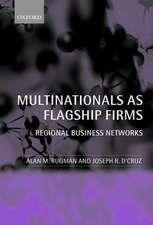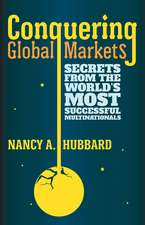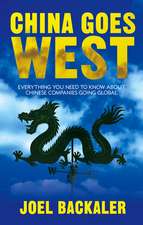The Competitive Advantage of Emerging Market Multinationals
Editat de Peter J. Williamson, Ravi Ramamurti, Afonso Fleury, Maria Tereza Leme Fleuryen Limba Engleză Paperback – 3 apr 2013
| Toate formatele și edițiile | Preț | Express |
|---|---|---|
| Paperback (1) | 344.20 lei 6-8 săpt. | |
| Cambridge University Press – 3 apr 2013 | 344.20 lei 6-8 săpt. | |
| Hardback (1) | 567.97 lei 6-8 săpt. | |
| Cambridge University Press – 3 apr 2013 | 567.97 lei 6-8 săpt. |
Preț: 344.20 lei
Nou
Puncte Express: 516
Preț estimativ în valută:
65.87€ • 71.53$ • 55.33£
65.87€ • 71.53$ • 55.33£
Carte tipărită la comandă
Livrare economică 22 aprilie-06 mai
Preluare comenzi: 021 569.72.76
Specificații
ISBN-13: 9781107659414
ISBN-10: 1107659418
Pagini: 374
Ilustrații: 21 b/w illus. 32 tables
Dimensiuni: 142 x 229 x 17 mm
Greutate: 0.6 kg
Ediția:New.
Editura: Cambridge University Press
Colecția Cambridge University Press
Locul publicării:New York, United States
ISBN-10: 1107659418
Pagini: 374
Ilustrații: 21 b/w illus. 32 tables
Dimensiuni: 142 x 229 x 17 mm
Greutate: 0.6 kg
Ediția:New.
Editura: Cambridge University Press
Colecția Cambridge University Press
Locul publicării:New York, United States
Cuprins
Introduction Peter J. Williamson, Ravi Ramamurti, Afonso Fleury and Maria Tereza Leme Fleury; Part I. Innovation and Competitive Advantage: 1. Innovation by Brazilian EMNEs Moacir de Miranda Oliveira Junior, Felipe Mendes Borini and Afonso Fleury; 2. Innovation by Russian EMNEs Sergey Filippov and Alexander Settles; 3. Innovation by Indian EMNEs Nikhil Celly, Jaideep Prabhu and Venkat Subramanian; 4. Innovation by Chinese EMNEs Peter J. Williamson and Eden Yin; Commentaries on Part I: i. The contribution of innovation to EMNEs' competitive advantage Bridgette Sullivan-Taylor; ii. Innovation in emerging markets and the rise of emerging market MNEs Ram Mudambi; Part II. Value-Chain Configuration and Competitive Advantage: 5. Value-chain configuration of Brazilian EMNEs Afonso Fleury, Maria Tereza Leme Fleury and Felipe Mendes Borini; 6. Value-chain configurations of Russian EMNEs Valery S. Katkalo and Andrey G. Medvedev; 7. Value-chain configurations of Indian EMNEs Suma Athreye; 8. Value-chain configurations of Chinese EMNEs Kaimei Wang and Yongjiang Shi; Commentaries on Part II: i. How emerging market multinational companies upgrade capabilities using value-chain configuration in advanced economies Alvaro Cuervo-Cazurra; ii. Value-chain configurations of emerging country multinationals Jagjit Singh Srai; Part III. Mergers and Acquisitions and Competitive Advantage: 9. Cross-border M&A and competitive advantage of Brazilian EMNEs Alvaro B. Cyrino and Erika P. Barcellos; 10. Cross-border M&A and competitive advantage of Russian EMNEs Kalman Kalotay and Andrei Panibratov; 11. Cross-border M&A and competitive advantage of Indian EMNEs Ravi Ramamurti; 12. Cross-border M&A and competitive advantage of Chinese EMNEs Peter J. Williamson and Anand P. Raman; Commentaries on Part III: i. Cross-border M&A by the new multinationals: different reasons to 'go global' Simon Collinson; ii. Cross-border acquisitions by EMNEs Ravi Sarathy; Conclusion: rethinking the implications of EMNEs' rise Peter J. Williamson, Ravi Ramamurti, Afonso Fleury and Maria Tereza Leme Fleury; References; Index.
Recenzii
'This volume is an important and thoughtful contribution toward understanding the roots, evolution and current extent of the competitive advantages that help emerging market multinationals to become global players in the world FDI market.' Karl P. Sauvant, Vale Columbia Center on Sustainable International Investment, Columbia Law School
'Emerging market multinationals (MNEs) are seizing with gusto the opportunities of globalization and of the global economic crisis. They spread their wings, deploy their ownership advantages, acquire the assets they lack, such as brands, patents and distribution channels, and take market share from multinationals headquartered in developed economies. The Competitive Advantage of Emerging Market Multinationals analyses the processes that are driving the fast accumulation of global capabilities and networks by BRIC-based MNEs. The reassessment of the explanatory power of existing theories of international business will be of great value to scholars and students; managers and policy makers will also find useful insights that can hopefully lead to better decision-making for all interested stakeholders.' Andrea Goldstein, OECD
'The Competitive Advantage of Emerging Market Multinationals investigates how firms based in Brazil, Russia, India and China are developing new products and processes, configuring their international value chains, and acquiring and exploiting capabilities through mergers and acquisitions. One exciting feature of this book is the parallel treatment of the strategies used by Brazilian, Russian, Indian and Chinese firms in these three areas. This book is a must-read for anyone eager to understand the international expansion of firms based in these four countries.' Jean-François Hennart, Center for Research in Economics and Business, Tilburg University, The Netherlands
'Emerging market multinationals (MNEs) are seizing with gusto the opportunities of globalization and of the global economic crisis. They spread their wings, deploy their ownership advantages, acquire the assets they lack, such as brands, patents and distribution channels, and take market share from multinationals headquartered in developed economies. The Competitive Advantage of Emerging Market Multinationals analyses the processes that are driving the fast accumulation of global capabilities and networks by BRIC-based MNEs. The reassessment of the explanatory power of existing theories of international business will be of great value to scholars and students; managers and policy makers will also find useful insights that can hopefully lead to better decision-making for all interested stakeholders.' Andrea Goldstein, OECD
'The Competitive Advantage of Emerging Market Multinationals investigates how firms based in Brazil, Russia, India and China are developing new products and processes, configuring their international value chains, and acquiring and exploiting capabilities through mergers and acquisitions. One exciting feature of this book is the parallel treatment of the strategies used by Brazilian, Russian, Indian and Chinese firms in these three areas. This book is a must-read for anyone eager to understand the international expansion of firms based in these four countries.' Jean-François Hennart, Center for Research in Economics and Business, Tilburg University, The Netherlands
Descriere
A rigorous analysis of how the innovative practices of emerging multinationals from the BRIC countries are transforming global competition.















